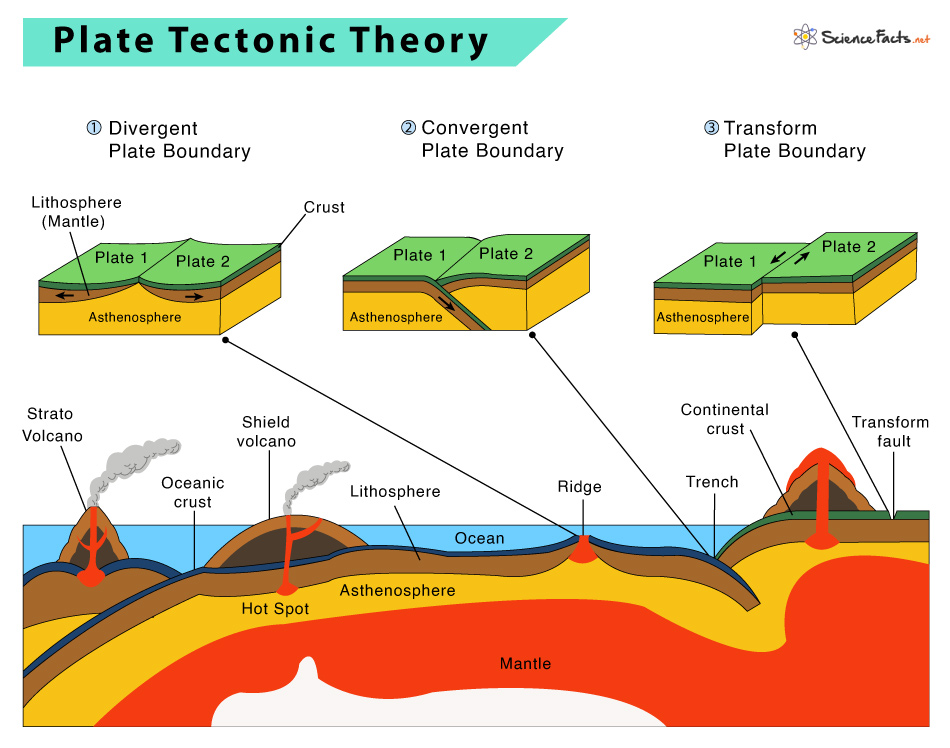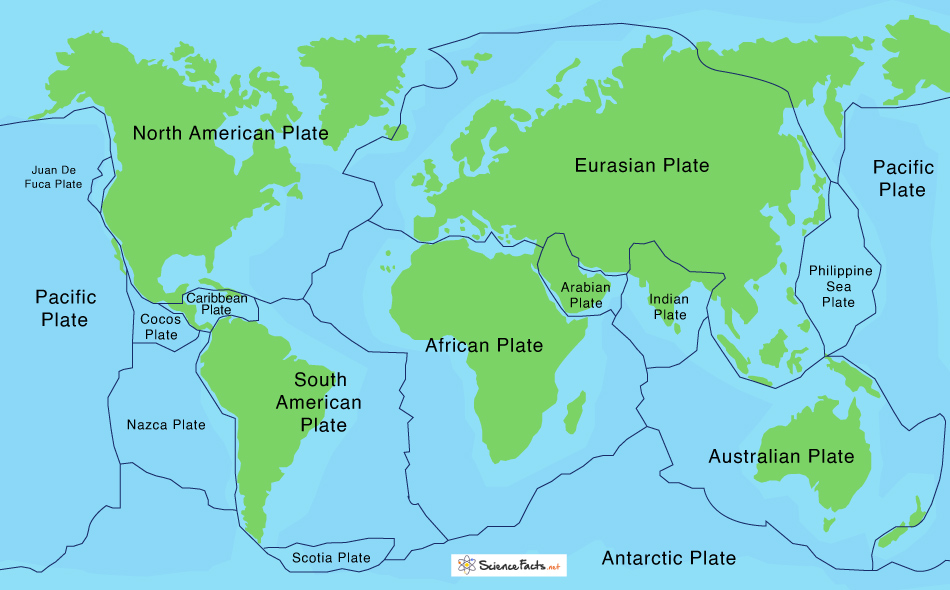Plate Tectonics
What are Tectonic Plates
Tectonic plates are large, irregular-shaped slabs of rock making up the Earth’s crust and upper mantle. They are found to float on top of a semi-liquid layer of rock called the asthenosphere.
Plate Tectonic Theory
Who Discovered Plate Tectonic Theory
Plate tectonic theory began in 1915 when Alfred Wegener proposed his theory of continental drift. Later, between the 1950s and 1970s, Wegner’s theory was updated and accepted to form the plate tectonic theory and became the modern version of continental drift.
What does the Theory of Plate Tectonics State
The theory of plate tectonics states that the Earth’s solid outer crust, the lithosphere, is divided into plates that move over the semi-liquid upper portion of the mantle, the asthenosphere.
Thus, plate tectonics is a scientific theory that deals with the large-scale motion of the plates that makes up the Earth’s lithosphere. From the deepest trench of oceans to the highest mountains, plate tectonics explains the movement of Earth’s surface in the past and present.
According to the theory of plate tectonics, the Earth’s outer shell is divided into large slabs of solid rocks, called plates, that move over the rocky inner layer above the Earth’s core, the mantle. The solid outer layer includes the crust and the upper mantle and is called the lithosphere. Below the lithosphere is a highly viscous layer called the asthenosphere. It is kept malleable by the heat deep within the Earth. It thus helps to lubricate the inner tectonic plates, allowing the lithosphere to move around.
The above theory revolutionized the Earth sciences by explaining how the movement of geologic plates causes mountain buildings, volcanoes, and earthquakes.
What are Tectonic Plates Made of
Tectonic plates are composed of the continental and oceanic crust or lithosphere.
Continental crust is composed of granitic rocks made up of relatively lightweight minerals such as quartz and feldspar. In contrast, oceanic crust is composed of basaltic rocks, which are much denser and heavier. Because continental rocks are much lighter, the crust under the continents is thicker (as much as 100 km). In contrast, the crust within the oceans is generally only about 5 km thick. Thus these massive rocks float despite their heavyweight.
What Causes Tectonic Plates to Move and Why
The underlying driving force that causes plate tectonics is convection currents or heat generated from the radioactive processes in the Earth’s mantle. According to Van der Elst, “It is kind of like a pot boiling on a stove.”
Due to the convection in the lithosphere and asthenosphere, the plates move relative to one other at different rates, between one to six inches per year. The plates above the mantle repeatedly collide, stick together, and then rip apart. Geologists named the places where segments meet and divide as plate boundaries.
How Fast Do Tectonic Plates Move
The tectonic plates move at an average rate of one to two inches (three to five centimeters) per year.
Types of Tectonic Plate Boundaries
The movement or shifting of the plates creates three types of tectonic boundaries. They are named divergent boundaries, convergent boundaries, and transform boundaries based on the unique geological feature they trigger.
1. Divergent Boundaries
It occurs when two plates slide apart, forming a narrow rift valley. Here, geysers gush out super-heated water and magma, or molten rock that rises from the mantle and solidifies into basalt, forming a new crust. In the ocean, this same process creates mid-ocean ridges. Hot magma from the mantle wells up at these ridges, forming new ocean crust, pushing the plates apart. Underwater mountains and volcanoes can rise along this seam, in some cases forming islands.
According to National Geographic, the mid-ocean ridge, the most extended mountain range on Earth, is 65,000 kilometers (40,390 miles) long and 1,500 kilometers (932 miles) wide divergent boundary.
2. Convergent Boundaries
It occurs when plates collide with one another. The collision bulges the edge of one or both plates, forming a mountain range or causing subduction of one of the plates under the other, creating a deep seafloor trench. Here, continental crust is created, and oceanic crust is destroyed as it subducts, melts, and becomes magma. Convergent plate movement also creates earthquakes and forms chains of volcanoes.
The highest mountain range, the Himalayas, was formed almost 55 million years ago when the Eurasian and Indo-Australian continental plates converged. The island of Cyprus was also formed at a convergent boundary between the African and Eurasian plates.
3. Transform Boundaries
It occurs when plates move sideways to each other. The slip-sliding motion of plate boundaries triggers many earthquakes.
California’s San Andreas Fault, where the North American and Pacific tectonic plates grind past each other, is an example of a transform boundary.
Tectonic Plates Map: Where are they Located
Earth being spherical, its tectonic plates is broken into dozens of curved sections. The border between two tectonic plates is known as a boundary. Based on the size of the plate, they are categorized into major, minor, and micro.
1. Major Plates
According to the World Atlas, there are seven major tectonic plates in all. They are listed below in order of their size.
- Pacific Plate – 103,300,000 sq km
- North American Plate – 75,900,000 sq km
- Eurasian Plate – 67,800,000 sq km
- African Plate – 61,300,000 sq km
- Antarctic Plate – 60,900,000 sq km
- Indo-Australian Plate – 58,900,000 sq km
- South American Plate – 43,600,000 sq km
However, according to recent research published in Nature, the Indo-Australian plate has cracked over the last 10 million years, forming a separate Indian and Australian plate. These plates, if included, will increase the major plates to eight.
2. Minor and Micro Plates
There are ten minor plates and the Juan De Fuca Plate, which is a microplate. They are listed below in order of their size.
- Somali Plate – 16,700,000 sq km
- Nazca Plate – 15,600,000 sq km
- Philippine Sea Plate – 5,500,000 sq km
- Arabian Plate – 5,000,000 sq km
- Caribbean Plate – 3,300,000 sq km
- Cocos Plate – 2,900,000 sq km
- Caroline Plate – 1,700,000 sq km
- Scotia Plate – 1,600,000 sq km
- Burma Plate – 1,100,000 sq km
- New Hebrides Plate – 1,100,000 sq km
- Juan De Fuca Plate – 250,000 sq km
Evidence of Plate Tectonics
There are multiple pieces of evidence of plate tectonics.
- Distribution of Fossils: Fossils on different continents are similar to fossils on continents that were once connected. When the continents split, different life forms developed.
- Occurrence of Earthquakes: Most continental and oceanic floor features are formed due to earthquakes. The exact pattern is explained by whether the plates are converging to create mountains or deep ocean trenches, being pulled apart to form new ocean floors or sliding past each other to create faults.
- Location of Continental and Ocean Floor Features: Distributions of rocks within the Earth’s crust, including minerals, fossil fuels, and energy reserves, are a direct result of the history of plate motions and collisions and the subsequent changes in the configurations of the continents and ocean basins.
Plate Tectonics and the Ring of Fire
The Ring of Fire also called the Circum-Pacific Belt, is a horseshoe-shaped belt around the Pacific Ocean covering a region of almost 40,000 km (24,900 miles) long and 500 km (310 miles) wide.
The region covered by the Ring of Fire includes the following plates: Pacific, Juan de Fuca, Cocos, Indian-Australian, Nazca, North American, and Philippine.
Active volcanoes and frequent earthquakes characterize it. Seventy-five percent of the Earth’s volcanoes and ninety percent of Earth’s earthquakes occur along its path, including seismic events.
FAQs
Ans. No, Mars does not have plate tectonics.
Ans. Tectonic plate boundaries are associated with earthquakes and volcanoes.
Ans. We live on the lithosphere.
Ans. Alfred Wegener came up with the theory of plate tectonics.
Ans. The Pacific Plate is the largest tectonic plate.
Ans. No, the moon does not have plate tectonics.
Ans. Large Mountain chains influence the circulation of air in the atmosphere and thus can affect climate.
Ans. The main difference between continental drift and plate tectonics is that plate tectonics describes the features and movement of the Earth’s surface in the present and the past. In contrast, continental drift describes the drifting of Earth’s continents on the ocean bed. Thus, the theory of continental drift did not explain why Earth’s continents are moving.
Ans. A divergent boundary forms when tectonic plates move away from each other.
Ans. The advantages are:
1. Generate land and landforms
2. Stabilize climate over the long-run
The disadvantages are:
1. It causes volcanism and earthquakes that cause a mass extinction of life and life forms on Earth. The Permian-Triassic extinction, the Triassic-Jurassic extinction, and the Late Devonian extinction are examples.
2. The hypothetical ‘snowball earth event’ in which the Earth was encased entirely in a thick layer of ice is thought to be the likely cause of the movement of tectonic plates.
-
References
Article was last reviewed on Friday, February 17, 2023





